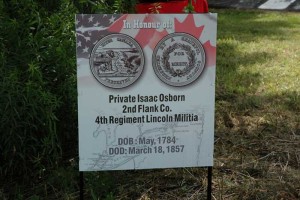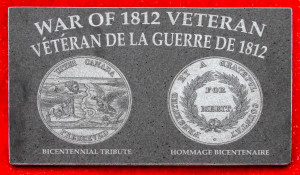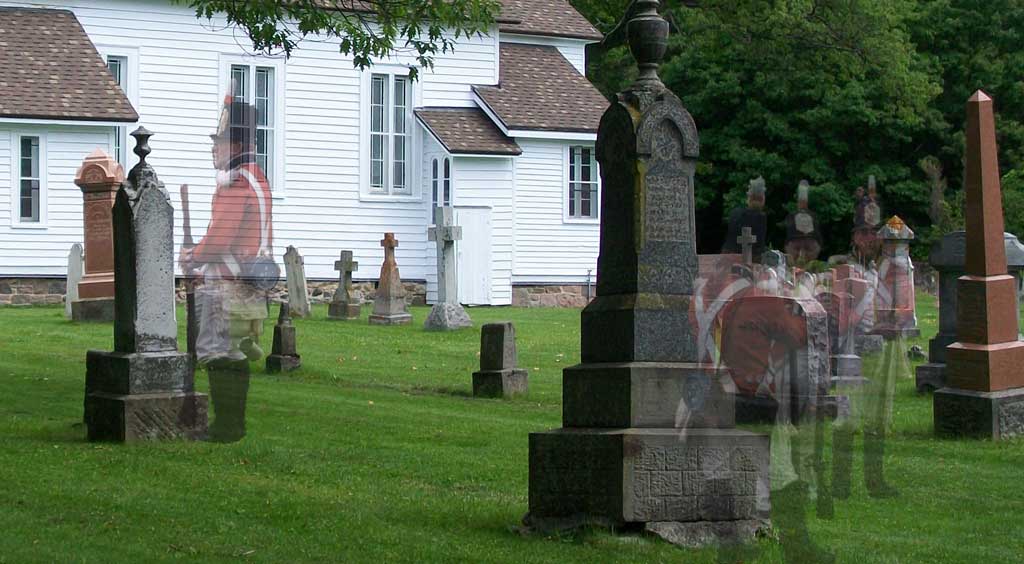When it comes time for your plaque ceremony, we created this outline with online forms and samples that you can download to help you plan. We decided that learning by doing and sharing is a great way to help other’s plan their events.
The suggestions and samples are courtesy Bill Young UE, Brenda Denyes and myself. We hope that you find this useful and informative.
Questions for the Cemetery
- Can you dig the hole for the paver on your own?
- If the cemetery has to dig the hole, what is the cost?
- If you’ll be gluing it to the paver will the cemetery allow you or will they have to?
- Is there a size limitation? For example, I encountered a situation where if the stone was less than a certain size, I could bury, over that size and the cemetery had to bury. Incidentally, if there’s no size limitation, Brenda recommends a stone that’s 24″ x 6″ x 8″ which will likely require two people to move, but also makes it more difficult to steal.
- Does the stone have to be placed a specific way? For example, flush with the ground? This is to allow the grass to be cut without hitting the stone.
- Since this is a public event, does the cemetery require “event insurance” to protect you and the cemetery from someone twisting an ankle and potentially suing?
- Will they provide signage on the day, directing the public to the location in the cemetery of your event?
- In all cases, what are associated costs and timelines?
Creating a Press Release
A Press Release is a short, usually a single page, outlining what you’re event is about. It’s used by all people that are looking for information about your event. You should provide enough information to get people interested in attending and state whether or not the event is open to the public… although usually, if it’s closed to the public, there’s not much point it creating a release in the first place.
It starts with a title of your event that should spell out the intent immediately. Something like, “Local Veteran of the War of 1812 to be commemorated”
Next is the body of your release, starting with the location (of your event), followed by the date (of the release, not the event). For example, PICTON, ON, AUG 12 2015 — Into the body of the Press Release.
And finally, although not explicitly required any more, end with “— 30 —” centred on a line by itself. This is a through back to teletype days when you never new when the release was finished and the next starting because it was one big long roll of paper in the machine. Today it’s used to indicate that you’re not missing any pages.
There are Sample Press Releases for download at the bottom of this page.
Contacting Local Media
In this department, your imagination is the limit. Below are a couple of suggestions. Be sure to send them a copy of your Press Release so they have an idea of what’s going on and whether or not it’s relevant to you.
Also, be sure to ask them if they can recommend anyone else in the area that might be interested. Most event companies all know each other.
In all cases, the more lead time that you can give the various societies, groups and individuals, the better chance you have of a good turnout.
- The local Museums and Historical Societies.
- The Re-enactment community in Canada is huge and quite spread out. Usually the local Museum will have information on who’s local. Note, however, that anyone that’s active in re-enacting usually requires at least six weeks notice since there are events nearly every month through the summer.
- The local branch of the Legion. The Legion has been a great supporter of this project and I want to thank them all for taking the time to attend almost all ceremonies. On Remembrance Day they ensure that all veterans are remembered and now that the War of 1812 Veterans are finally being recognized and marked, they’ll usually place a poppy on their graves as well.
- The local Churches can be a good source of information and help. Be sure to notify them of your event.
- With reporters contact the paper via the internet, about a month ahead. Keep in mind that some local papers are monthly or twice monthly. Then follow up with a phone call a week later. Then gave them a reminder email a week before the event. Press before the event it great to get them there. The after press coverage is great to encourage others to get their markers.
- Hand deliver invitations to the citizens in the two or three blocks around the cemetery. This was done to get them on “our” side to protect the cemetery and also as good PR for the extra cars on these quiet streets the day of the ceremony. It also explained what was going on when we dug the hole to inset the marker stone. I used a 24 x 8 x 6 paver stone with the marker on the 8 inch top side and the 6 inches in the ground. It was considerable heavier to “walk off with” and really would need two men to carry it easily.
- Send your Press Release and invitation or write a short article for the UELAC (United Empire Loyalists of Canada) and OGS (Ontario Genealogical Society) in the area. Both have newsletters for their members as well as an online site that will help to promote your event and the program.
- Send your Press Release and invitation to the MP. MPP & Mayor etc. to give them the background information. You’d be surprised at how many actually attend.
- You can also use Facebook OGS, UEL, historical societies in the area of the cemetery.
Creating an Information Pamphlet
At this point you should have a good idea of who’s going to be attending your event and what they’ll be doing.
An Information Pamphlet serves the dual purpose of educating everyone in attendance of what the Agenda is, and who the Veteran is and what part he played in the War of 1812.
When scheduling people for an event, it’s a hard chore to make sure that it’s interesting for the audience and that you get your point across. If there is a lot of speakers, I usually like to intersperse action between the speeches. this keeps it more interesting for the audience and less likely for them to fall asleep. If you have the luxury of timing your speeches, try to keep them to less than five minutes per speaker. Longer and you’ll lose interest, unless they’re very talented at public speaking.
Also, make sure that you identify who the MC (Master of Ceremonies) is. This way if anyone has a question, they know who to direct their question to.
When you’re trying to schedule the agenda as the various participants how long they need and schedule a little longer. If they run on time or shorter, jump in and request that the next participant go.
However you decide to schedule it, include an opportunity for photos with the various guests, both for the website, but for news releases as well.
The number of pamphlets to print is always a good question. Bill printed 70 for his event and had more than a hundred in attendance. I printed a hundred and had 25 in attendance. My recommendation… printed copies are inexpensive so if you have an idea of the number of people you’ve tried to reach, assume 75% will turn out. If the attendance exceeds that, you can always suggest they download and print a copy from the website… Just remember to send me a copy to post.
Other Considerations

Laminated posters on an easel make for great photos as well as informing the public. They can be laminated and mounted on foam-core at Staples or any other printing services company. Make sure to give them a photo that’s sufficient quality to blow-up.
Flags can be used for multiple purposes… a larger one to reveal the plaque and smaller ones on hand-poles to decorate the periphery of the plaque and/or the tomb of the veteran.
If you plaque is not yet mounted on its block for burial, then a table with covering is a nice touch for viewing.

Although the plaque does not bear your veterans name, we’ve had at lease one instance where the veterans name has been carved into the edge of the plaque… a very nice touch.
Consider the time of your event and note the location that the sun will be at and adjust your positioning accordingly. The last thing you need is for your audience to be staring into a blinding afternoon sun.
If you’re expecting a lot of speeches you may want to consider renting some kind of microphone and amplifier. These can be had from any AV (Audio-Visual) rental company. Alternatively, you could consider a portable karaoke system. The downside of both these is you require power. Therefore, my solution is to talk loudly. Fortunately, in a cemetery, you usually don’t have a lot of ambient noise to compete with.
Sign’s to get to your location. Usually the cemetery is set up to handle this, but be sure you clarify with them ahead of time. You don’t want a lot of lost people roaming the cemetery.
Event Day
On event day, get their early and ensure everything is set up and ready to go. You’ve far better off to be waiting, then to arrive late to a crowd that’s wondering why your 1:00pm event isn’t started and no one around to say why.
Assuming you’re MC’ing the event, start it promptly at the time promised. Don’t get caught up in reminiscing with family members, plenty of time for that afterward. Many of the participants attending have other events or schedules that they need to attend, so stick to your schedule… within reason.
There will always be extenuating circumstances that will cause your event to run longer than anticipated, weather being a big culprit. Don’t sweat it, just keep it moving. An audience will be forgiving in rain, especially if they see you being drenched and not so forgiving if you’re the only one under shelter.
Finally, HAVE FUN! Running and event is a complex process dependant on a large number of factors that you can’t control with people that you’ve never met before. When all said and done, be proud of what you’ve accomplished and be sure to get photos before everyone leaves and send them to me for posting with your veteran.
Sample Files for Downloading

Sample Press Release – S Hancocks
Sample Press Release – Bill Young

